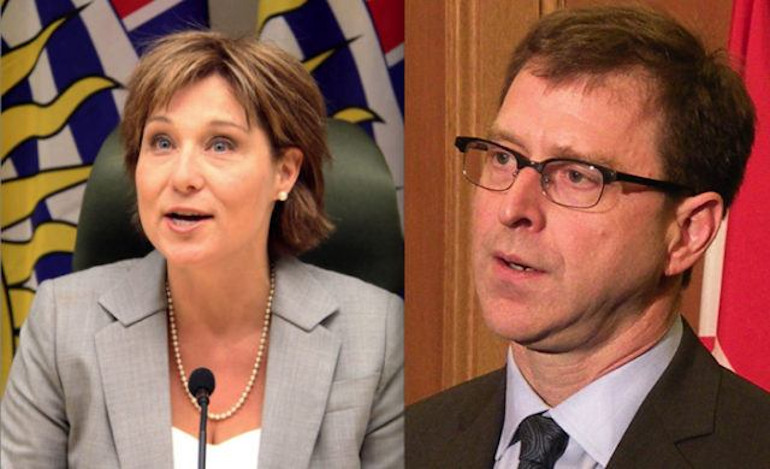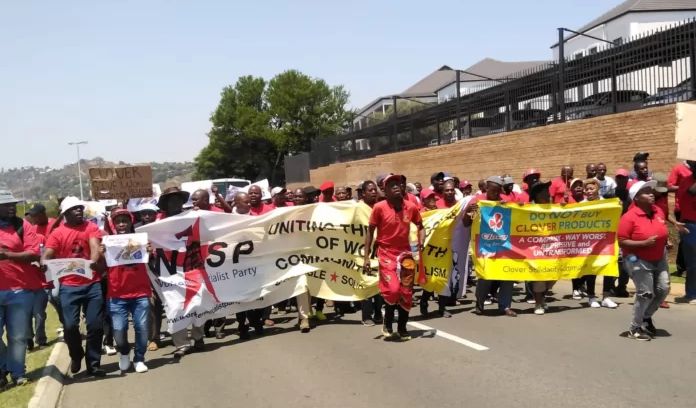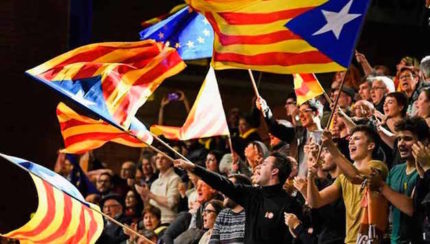Written by Socialist Alternative members in BC.
On May 14 the New Democratic Party (NDP) achieved a stunning defeat in British Columbia’s provincial election, losing to the BC Liberals for the fourth time.
It wasn’t supposed to be like this. Just over a year ago the Liberals were in free fall after choosing a new leader, Christy Clark, in 2011. They were stumbling from one crisis or scandal to another. A year ago, they lost two by-elections to the NDP, one in an area where the NDP had never before elected a representative. In the run up to the election, 6 members of the Cabinet and over one third of all sitting Liberals announced they would not run again for election. A year ago, according to opinion polls, NDP support was over 45%, the Liberals were in the mid 20s, the Conservatives just behind in the low 20s and the Greens at nearly 10%. There was also strong evidence that people in BC wanted action to protect the environment, reduce poverty and increase taxes on the rich.
After the polls closed the Liberals had won again with 44.1% of the vote compared to the NDP’s 39.7%. Compared to the seats before the election, the NDP gained 4 seats and lost 6, the Greens won one seat for the first time and the Liberals lost 5 seats and gained 9 seats (6 from the NDP and 3 from independents). The results were very similar to the 2009 and 2005 elections.
|
|
2009 (last Election) |
Before 2013 Election |
2013 Election
|
||
|
Turnout |
Votes |
% |
|
Votes Counted |
% |
|
|
1,651,567 |
51 |
|
1,803,051 |
58 |
|
|
Seats |
% of Vote |
Seats |
Seats |
% of Vote |
|
Liberals |
49 |
45.8 |
45 |
49 |
44.1 |
|
NDP |
35 |
42.1 |
36 |
34 |
39.7 |
|
Greens |
0 |
8.2 |
0 |
1 |
8.1 |
|
Conservatives |
0 |
2.1 |
0 |
0 |
4.8 |
|
Independents & Others |
1 |
1.1 |
4 |
1 |
3.3 |
|
Total |
85 |
99.3 |
85 |
85 |
100 |
Tale of Two Strategies and Campaigns
How did this upset happen? The Liberals (who, despite their name, are the main right-wing conservative party in the province) had a clear two-step strategy. After the two by-election defeats, which were in part due to a new, even more right-wing, Conservative party taking votes, the Liberals went after the Conservatives to crush the threat from the right. Christy Clark stated that “It’s never been clearer that only a unified free enterprise coalition can defeat the NDP”. No doubt there were backroom discussions with some Liberal backers flirting with the Conservatives clearly explaining that the Conservatives could not win (that is why the conservatives here are called Liberals!) and that the only outcome of supporting the Conservatives would be to allow the NDP an easy win. The Conservatives were pushed back, made a series of blunders and looked incompetent; in the election they gained less than 5% of the vote and only came second in one of 85 seats and only gained more that 3,000 votes in 2 seats.
Meanwhile the NDP’s strategy in the year before the election was to be cautious on the grounds that if they were are too radical they might frighten away voters and lose the election. So they spent the year lowering expectations, telling campaigns and organizations sympathetic to the NDP not to expect too much in the election platform. The general line was we know you may be disappointed but it will be a start.
This cautious approach of the NDP continued into the election campaign with a set of very moderate reforms which in many cases hardly scratched the surface of what is needed. Even most NDP activists agreed the platform was far too modest – none were confident in defending it as a good platform. The NDP’s slogan epitomized this cautious approach, “Change for the Better, One Practical Step at a Time”.
The NDP failed to make poverty, health, education or the environment election issues, as their platform was so moderate, with very little change on anything. They promised to raise 8,400 children out of poverty – out of a total of over 100,000 children living in poverty in BC; to raise welfare by $20 a month, from $610 to $630 a month in 2015; and a very modest increase in taxes on the rich, after the Liberals had given away $41,000 per person each year to the richest 1%. It was hardly a campaign to connect emotionally with people or generate enthusiasm.
The NDP set out to not run personal attack ads, which is probably a good moral stance, but the NDP hardly even criticized the many past failures of the Liberals or the falsehoods and myths of the Liberal platform, especially on jobs. The NDP seemed to forget that there is a difference between a negative and a critical campaign. The Liberals claim to have a job creation strategy, yet since September 2011 when they launched the B.C. Jobs Plan 37,000 private-sector job have disappeared. (http://www.vancouversun.com/mobile/business/economy/lost+jobs+January+Canadian+unemployment+rate+fell+cent/7937696/story.html)
The Liberals’ strategy was a very different two pronged approach. There was a series of vicious attack ads on the NDP and its leader, Adrian Dix, digging up every past misdemeanour, claiming the NDP couldn’t be trusted and making wild allegations that last NDP government destroyed jobs and bankrupted the province (not true). The other prong was Christy Clark, out-going with a big smile, travelling the province talking all the time about “Strong Economy, Secure Future” (a contrast to the NDP’s cautious slogan) and creating jobs. In almost every photograph she was wearing a hard hat and talking with workers. She didn’t appear in the attack ads, so appearing to keep to the high ground, although making oblique references to the themes of these ads.
The NDP promise very little and the Liberals promised jobs. Although many people supported action on poverty and the environment that wasn’t on offer, so many people voted for what they believed would at least provide a strong economy and job. Most people associate the ‘economy’ with jobs, food on the table, a roof over their heads, a future for their kids and maybe a holiday; so talk about the economy resonates. Of course socialists know that when the rich and their politicians talk about the economy they really mean profits. The Liberals’ economic and jobs strategy centred on resource extraction and export.
Liquid Natural Gas Balloon
Central to the Liberal agenda is the proposal to export Liquid Natural Gas, claiming that over 30 years this will generate $1 trillion in economic activity, 100,000 high paying jobs and $100 billion for a BC Property Fund (to be used to pay off BC government’s debts). This proposal, according to most in the energy industry, is a fantasy. It is true that BC has large amount of natural gas, but extraction relies on fracking, which uses large amounts of water and energy and contaminates ground water and releases green house gases. (http://www.policyalternatives.ca/sites/default/files/uploads/publications/BC%20Office/2011/11/CCPA-BC_Fracking_Up_SUMMARY.pdf). Even more telling are the energy needs to compress a gas to a liquid so it can be shipped overseas. The Liberals are talking about 5 gas export terminals operating within a decade; the likely energy demands of extraction and compression is between 20 – 40% of the total electricity generated in BC (61,000 Gigawatt hours). This means either: a huge increase in electricity imports (from where?); a big increase in electricity generated from burning fossil fuels (oil and gas); or the construction of several new huge hydro dams. Or possibly all of the above.
But the biggest lie of all this is that the dollar figures are a myth. At present there is a glut of natural gas in North America and a shortage in East Asia as China expands its use and Japan has switched much of its electricity generation from nuclear to natural gas. This means prices in Asia are around 4 times higher than in BC at present. However, there are major plans to develop several large gas fields in Russia which will be on stream as soon as the BC ones and with cheaper prices, as there will be no need to compress the gas and then ship it across the Pacific. If these plans go ahead, BC will have invested a fortune in LNG, with all the new pipelines and compression terminals to sell to a market with other suppliers and with no mark up in price.
NDP: Environment and Jobs
The NDP attempted to strike a balance between jobs and the environment. However that is how they see it; a balance between two conflicting needs. The NDP did not have a strong enough environmental program to make big inroads into the Green vote. But its concerns about the environment were used by the Liberals to claim the NDP was anti-jobs, especially resource-based work. There are 3 major pipeline proposals in BC, two to ship bitumen from the Alberta tars to the coast and a natural gas pipe from north eastern BC to the coast. The bitumen and gas in these pipelines would be mainly for export. Before the election the NDP stated opposition to one tar sand’s pipeline – Northern Gateway; they supported the gas pipeline; and said they would review the other bitumen pipeline proposed by Kinder Morgan, which would use the port of Vancouver. Halfway through the campaign the NDP changed to say they were no longer in support of Kinder Morgan.
This allowed the Liberals to claim that the NDP were anti-resource extraction, and by implication jobs, and were unreliable as they had flipped their position. The shift by the NDP was too little too late to significantly sway Green voters, but it did help the Liberals seem stronger on jobs, especially in resource-based communities of the interior.
The Greens had the same share of the vote as in the last election, but this time they focused their efforts on a few seats, particularly in south Vancouver Island, where they elected their first MP to the Canadian parliament in 2011. This strategy paid off as they won their first seat in BC. It may be the case that some people voted Green rather than NDP, believing that the NDP was going to win and therefore they wanted to put pressure on it to be more radical. But it is hard to argue that the Greens cost the NDP the election; it was the NDP’s failure to put forward a bold strategy on social, economic or environmental issues.
NDP: Excuses and Results
Some in the NDP have blamed the results on voters not turning out as they thought the NDP would win, the Liberals whipping up fear, and the Liberals out-spending the NDP. None of these really stack up. If the NDP had enthused its supporters and won new ones they would have turned out. If the NDP had put forward a positive platform for jobs, the Liberals’ fear mongering would have had less impact. Of course the Liberals out-spent the NDP that is part of the territory. The NDP has to counter the money with activists and enthusiasm.
Some in the NDP have complained that the media was against them; what else did they expect? Most of the media are owned by private companies so of course they will support the right wing parties. But progressive change has almost always come in spite of the media. The media didn’t campaign for public health or gay rights or support unions to protect the environment. Just over a year ago the Liberals were in crisis, the NDP had a huge lead in public support and the public was looking for real change. The NDP damped down expectations so much that they lost the election.
As one commentator, David Beers, put it “In this election [the NDP’s] campaign hit lots of precise if small notes that a political journalist like myself might keep track of and tally, but overall the New Democrats apparently [did not strike] the themes that summoned enough inspiration. Campaigns are … emotional narratives.” A winning campaign needs content and emotion; Obama was good on emotion but thin on content. The NDP had neither content nor emotion.
The results for the NDP confirm the failure of their strategy. They lost 5 seats in the Vancouver suburbs – mainly working class communities where jobs are an immediate issue. The more resource-based areas of the interior of BC were a disaster for them. They lost one seat and failed to make any inroads in the seats they had hoped to win such as the four around Kamloops and Prince George. In fact in 3 of the 4 target seats the Liberal share of the vote increased and in 3 of the 4 the NDP share of the vote went down. In Kamloops North Thompson the NDP lost by 2.4% in 2009 with a Green running; in 2013 there was a Conservative and no Green, yet the NDP lost by 13%.
The most important gains for the NDP were in Vancouver where they won two seats, turning majorities for Liberals in the 2009 election of over 2,000 in Point Grey and 1,000 in Fairview into NDP majorities of 1,063 and 1,351. The NDP candidates were both on the radical wing of the party and spoke out on those lines, speaking outside the NDP’s official, narrow box. The Liberals they defeated were the Premier, Christy Clark, and the Minister for Health. These were no small achievements although unfortunately the Premier will continue to be Premier and will be given a safe seat to win in a by-election.
A Different Economic Outlook
The NDP has not yet travelled down the road of moving to the right as far as most of Europe’s former social democratic or communist parties. However, they face the dilemma of all moderate social democrats. They do not put forward a bold platform of change with real action on poverty and inequality, jobs, public services and the environment because they know that capitalism is opposed to these changes and they have no idea of working beyond the limits that capitalism sets. As a result, they end up putting forward only small tinkering changes.
More fundamentally, the Liberals, and other right-wing parties, believe in capitalism. The NDP knows there are problems with capitalism, but have no real answer of what to do or an alternative worldview.
The NDP did not shift towards a different economic model. They did not make a drive towards a green job economy, using the resources of BC to develop a clean renewable energy society. Neither did they point out the huge costs of poverty; it is estimated that the total costs of poverty are over $8 billion a year while the cost of a strong poverty reduction program is around $4 billion. A platform based on these ideas and reversing the tax cuts to the rich would have guaranteed good jobs for most of BC as well as good public services. But to win on such a platform the campaign should have started a year or more ago and the NDP would have had to be prepared to seriously challenge the big corporations’ domination of BC.
Don’t Mourn, Organize
After a few days of getting over the surprise, there is growing reflection among activists about the future. There is agreement that the best that could have been hoped for with an NDP government was that it would have been easier to get them to move under pressure; it was clear the NDP was not going to lead any real change.
It has always been the case real change comes from mass movements which push politicians to act. People who want change should not blame the voters or the Liberals’ scare tactics, but recognize that the NDP lost because of its weak platform and campaign. Because the NDP was unwilling to go beyond giving capitalism a nail trim, it did not offer an alternative vision for the future.
The election only records the mood on that day, things will change. Almost every government after winning an election faces crises and struggles; the same will be the case in BC. Socialist Alternative will work with others to build the movements and make links between the environmental, economic and social issues to develop a shared program for transformation of society.


